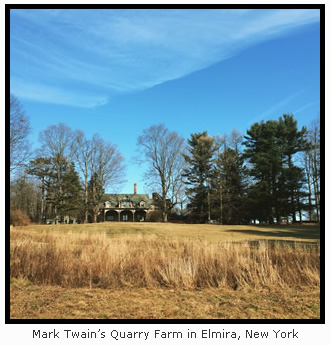
At long last, the pen is finally moving again.
I must apologize for taking a few months off. I didn’t really go anywhere, it’s just that Distilled History needed to take a breather. I needed a break so I could throw a few back with the Campbell Family, talk James Eads with fellow history pals, and enjoy the incredible gin selection at my new favorite watering hole. I also needed it because after bonking my head (quite badly) during a softball game in Tower Grove Park, things got a bit cloudy.
Well, maybe it was a bit worse than that. I lost my short-term memory for a few days, and docs told me that I suffered what is called a “subarachnoid hemorrhage”. It turns out that I’m actually quite lucky to be alive. Even better, I still remember all the useless stuff I’ve written about cocktails, cyclones, prostitutes, beer gardens, and all that other history I’ve compiled about my favorite city.
Well, almost my favorite city.
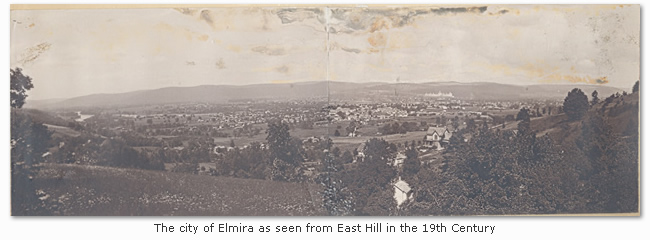 Some readers may recall that I am not a native St. Louisan. I’ve been here nearly twenty years, but I hail from Elmira, a small city located in upstate New York. Elmira is still, and will always be, my home. It’s where I was born, it’s where I became smitten with the Manhattan cocktail, and perhaps most importantly, it still contains my nutty (but wonderful) mother. As much as I love St. Louis, it simply can’t compete with that.
Some readers may recall that I am not a native St. Louisan. I’ve been here nearly twenty years, but I hail from Elmira, a small city located in upstate New York. Elmira is still, and will always be, my home. It’s where I was born, it’s where I became smitten with the Manhattan cocktail, and perhaps most importantly, it still contains my nutty (but wonderful) mother. As much as I love St. Louis, it simply can’t compete with that.
And as I detailed a couple of years ago, Elmira also has a rich and enlightening history. And since I spent the last week sitting in my hometown drinking ungodly amounts of gin with Mom, I’m kicking off 2015 with some Elmira history. St. Louis, I’m going to be writing about you for years to come (barring additional head trauma), so hang tight. I’ll be back with you soon enough.
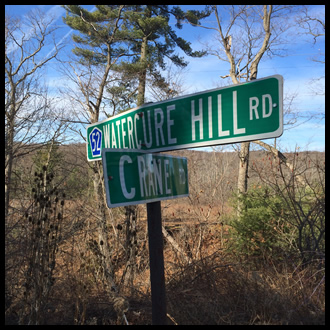 As many know, Elmira’s most notable historical asset is the great American author Samuel Clemens. And despite recent unfortunate activity, Elmira is a good place. You have to scratch the surface a bit to see it, but Elmira is filled with thousands of people who are proud of the city’s history.
As many know, Elmira’s most notable historical asset is the great American author Samuel Clemens. And despite recent unfortunate activity, Elmira is a good place. You have to scratch the surface a bit to see it, but Elmira is filled with thousands of people who are proud of the city’s history.
Elmira also has a fun little battle going with my fellow Missourians in the town of Hannibal over which area is the true “Mark Twain Country”. Hannibal has a case, but it’s tough to deny my hometown’s claim. Twain spent over twenty summers there, he fell in love (and got married) there, and best of all, he wrote much of his best stuff there.
But perhaps most significantly, he’s well… still there.
I always visit Mark Twain’s grave when I’m home in Elmira. I think it’s really cool that I can visit Twain and his beloved wife Olivia at the same time I visit a couple grandparents. All them share a current address in the (Bellefontaine-esque) Woodlawn Cemetery (and even better, my Grammy lies in peace less than twenty-five yards from another Elmira icon, Ernie Davis).
Anyway, good Elmira history goes far beyond Mark Twain. Much of it has absolutely nothing to do with the guy, but on my recent trip home I looked into a fun topic that shares a common denominator with the great author.
A simple road.
Let me paint the picture. Back in the day, perhaps after playing billiards and throwing a few back with pals at Klapproth’s Tavern on Lake Street, Mark Twain would hop into his carriage and steer it towards East Road (the same road I found myself standing on 150 years later). East Road was the path Mark Twain needed to get to Quarry Farm, his place of residence while summering in Elmira. On the way, Twain could look to his right and wave to Reverend Thomas Beecher, his good friend and the man who married him to Olivia Langdon. Beecher, an Elmira icon himself, had no difficulty acquainting himself to famous authors. His own sister only happened to write the best-selling novel of the 19th Century, a little tale she titled Uncle Tom’s Cabin.
(See what I’m doing here? Eat your heart out, Hannibal.)
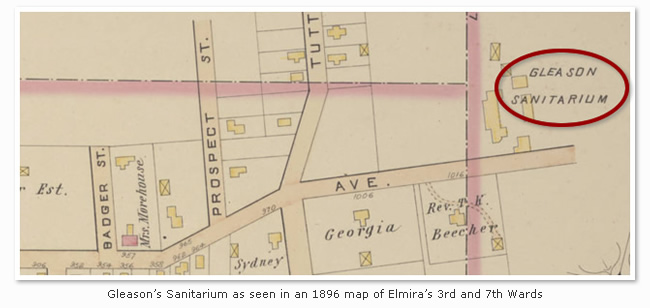
Anyway, as Twain’s carriage continued upward, Twain would keep an eye out for the hard left he needed on Crane Road, the final turn needed to get him home. But Twain wouldn’t be able do it without visually swallowing the enormous complex of buildings that appeared on his left. That resort, known as “Elmira’s Water Cure”, gave the road the name it bears today, Watercure Hill Road. Almost nothing remains of the resort today (I think), but it must have been a site to see in the days of Silas and Rachel Gleason, two remarkable physicians who came to Elmira in 1852 and opened one of the first hydrotherapy resorts in the United States.
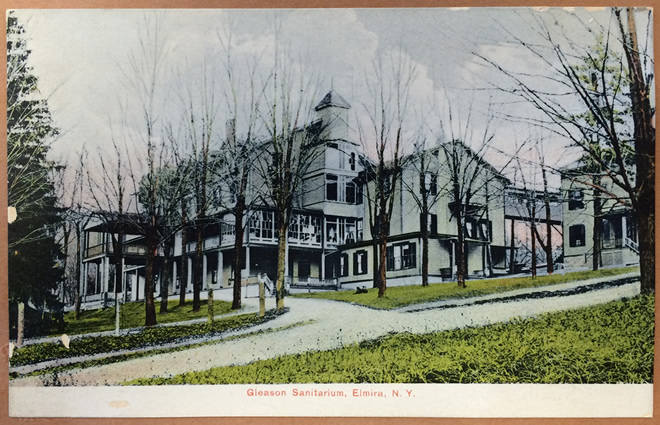
Silas Gleason was born in Massachusetts in 1818. After growing up in Vermont and attending Oberlin College in Ohio, he returned to Vermont and graduated from medical school in 1844. In the same year, he married Rachel Brooks, a teacher from Vermont who became interested in studying (and ultimately practicing) medicine with her new husband. The two soon focused on a growing medical movement popular in Germany and England at the time: “Hydropathy”, or “Hydrotherapy” as it’s known today.
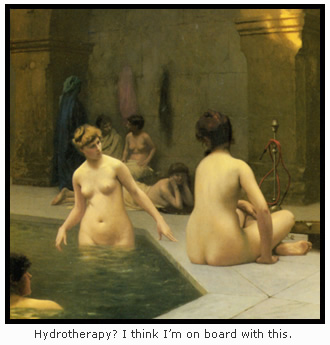
As WebMD puts it, Hydrotherapy is “the use of water to treat a disease or to maintain health.” In the 1850’s, many physicians believed that warm and cold baths, compresses, spraying people with water, drinking copious amounts of water, and even tightly wrapping naked people in blankets soaked in water could help ease pain, cure disease, and help relieve symptoms of chronic ailments.
In the 19th Century, common water treatments included “head baths” for vertigo and hypertension, cold showers for people suffering from melancholia, and even “arm baths” to relieve of all things, a sore throat. Extreme treatments included strapping naked women to chairs and hosing them down, a “treatment” some believed could aid in preventing a wife from straying from her marriage.
Modern medicine has helped our ancestors realize that treating cholera or tuberculosis with a warm foot bath wasn’t gonna cut it, but hydrotherapy isn’t entirely quack medicine. It’s hard to argue that a warm bath can’t provide a brief respite to anyone having a rough go. Hydrotherapy also promoted practices such as good hygiene (during a time when bathing on a daily basis was unheard of), drinking ample amounts of clean water (instead of say, rot-gut whiskey), and even the simple relief of splashing cold water on your face after a shitty day at the office.
Fast forward to 2014, and all of us are probably practicing hydrotherapy on some level.
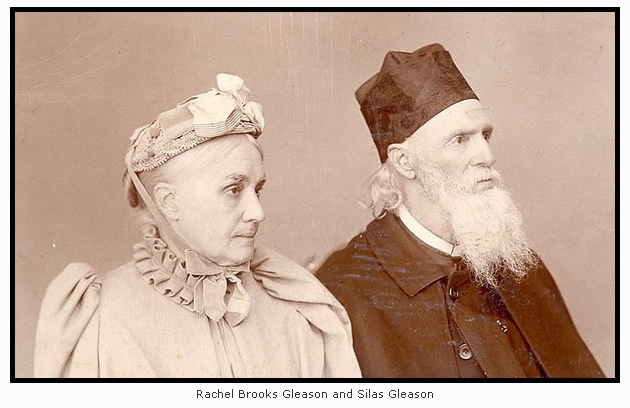
Unlike the guys fire hosing women trapped in really bad marriages, it seems Elmira’s water doctors had a sense of reason to them. Silas and Rachel Gleason did not profess to be groundbreaking scientists or proponents of rewriting medical theory. Instead, they promoted their means of treatment as a supplement to standard medical practices of the time. They had no desire to “do away with doctors” or promote new theories in curing disease. They simply believed in improving life by making many of the same behavioral choices many of us make today. Examples include exercising daily, eating healthy, and getting outside as much as possible. The Gleasons simply believed water could assist these actions by putting the body in balance, removing toxins, and cleansing the mind.

Even without their Water Cure, the Gleasons were something a remarkable pair. While many Elmirans likely believed they were a couple of flakes , and others offered skepticism about their methods of treatment (Mark Twain included himself among this group), the Gleasons did become respected and active citizens in their new community.
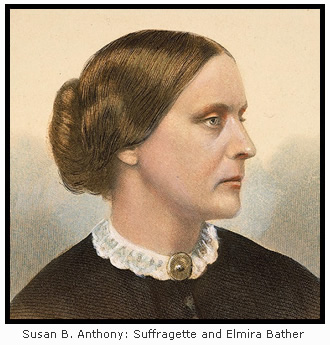 Before establishing the Water Cure in Elmira, Silas Gleason participated in the establishment of a medical school in central New York. He lobbied for the new school to admit female students, an almost unheard of idea at the time. But he won his case, and his wife Rachel became one of its first students. When she graduated in 1851, Rachel Gleason became one of the first women in United States history to hold a medical degree. And during many years as a co-founder of Elmira’s Water Cure, she was the only female physician in Chemung County.
Before establishing the Water Cure in Elmira, Silas Gleason participated in the establishment of a medical school in central New York. He lobbied for the new school to admit female students, an almost unheard of idea at the time. But he won his case, and his wife Rachel became one of its first students. When she graduated in 1851, Rachel Gleason became one of the first women in United States history to hold a medical degree. And during many years as a co-founder of Elmira’s Water Cure, she was the only female physician in Chemung County.
This fact could explain why Susan B. Anthony took notice of the Elmira’s Water Cure and eventually became a patient. It’s also possible Anthony was drawn to Elmira by Rachel Gleason herself. Dr. Gleason was a progressive thinker, intelligent, skilled, and undoubtedly an ideal acquaintance to have at the onset of a burgeoning women’s movement.
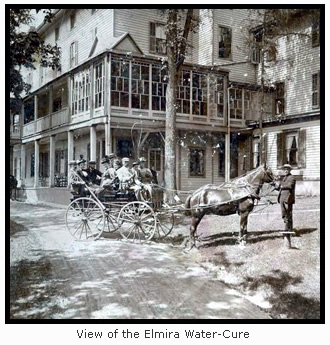
His wife’s personal physician, Samuel Clemens called her “the almost divine Mrs. Gleason”, and insisted that she treat his wife Olivia during each instance of childbirth. In one amusing story, it’s claimed that Gleason was called to Buffalo to tend to Olivia Langdon after the birth of a son. When Dr. Gleason attempted to leave after a few days, a panicked Clemens supposedly barred the door and made “horrendous threats” about what would happen if she was allowed to escape.
In 1870, she published a book titled Talks to My Patients that became a bestseller in the United States and England. Building on progressive ideals she held dear, the book focused primarily on women’s health, providing insight from years of treating women at the Water Cure. Along with providing advice on topics such as pregnancy and menstruation, she also displayed her progressive leanings by promoting the use birth control and candidly telling women to simply “enjoy sex”.
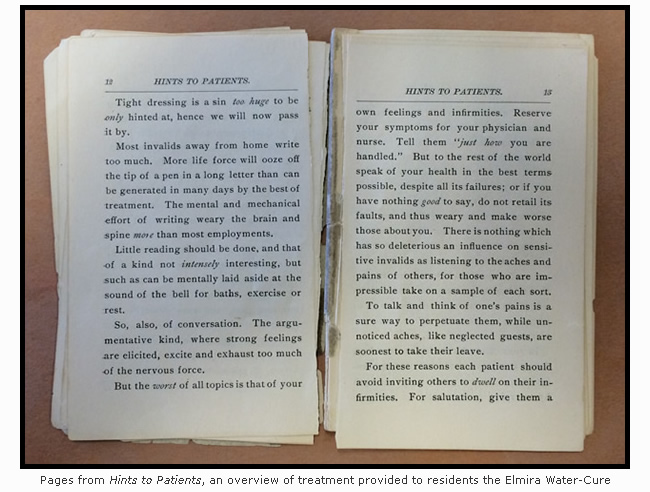
In 1850, Elmira was a town of about 10,000 people (it was incorporated in 1864). After visiting Elmira to treat a patient, Silas Gleason became convinced it was the perfect setting for a new Water-Cure home. With the support of his wife, they chose a quiet hill on the east side of town with a nearby glen that provided all the water they needed. The Gleasons called Elmira a “pretty town” with “delightful views” available among the “hills grand and the valley beautiful”. On nearly forty acres of wheat fields, they built their impressive complex. It opened to the public on June 1, 1852.

The main structure was four stories, flanked by two three-story wings. Over time, additional renovation and construction would expand it to enable the treatment of over 100 patients at a time. It was surrounded by nature trails, fruit trees, and vegetable gardens. It had a gymnasium, a bowling alley, and even a putting green. Bathrooms were over 100 feet long, enabling up to twenty women the ability to bathe privately at once. But Rachel Gleason was quick to point that patients should not expect hotel-like accommodations. It was a home for invalids, and strict rules were established. Along with scheduled water treatments, all patients were required to exercise twice daily, “quiet” was required during certain hours of the day, and smoking was not allowed in any part of “the Cure” except the billiard room.
Other more specific rules forbade patients from throwing anything out of open windows, driving tacks or nails in walls, and allowing children to play in the halls, the parlor, or on the veranda.
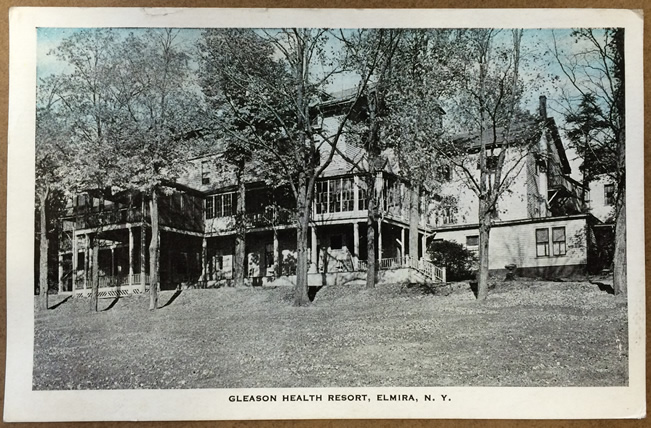
In 1852, a week’s stay at the Water-Cure ran from $7 to $10, depending on the desired level of treatment and accommodations (even an extra blanket added to the rate). That was a steep price for someone living in 1850, which means the thousands of patients treated by Silas and Rachel Gleason were usually people of means. While there, a host of resident doctors, nurses, and interns bathed, sprayed, wrapped, and dunked names of note that include the previously mentioned famed suffragette, Harriet Beecher Stowe, Clara Barton, most of the Langdon Family (Mark Twain’s in-laws), several children of Brigham Young, Vice President Shuyler Colfax Jr., and even Emily Dickinson’s mother.
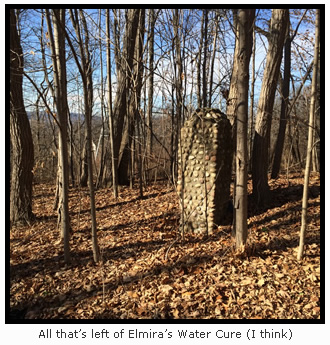
Finally, it must be noted the Water Cure was a fully successful venture. The Gleasons ran it for nearly fifty years, and it usually ran at full tilt. In the later years, it went through name changes (Gleason Sanitarium, Gleason Health Resort) and ownership changes (Dr. John C. Fisher took over in 1898) before Silas Gleason ultimately died in 1899. Moving to Buffalo after her husband’s passing, Rachel Brooks Gleason died in 1905.
As for the structure itself, the Water Cure was converted to a nursing home before closing for good in the wake of World War II. The buildings, bath houses, and remaining structures were all demolished in 1959.
Today, if one takes a drive up Watercure Hill Road (the road’s current name), it’s difficult to find any trace of what once stood at the corner where Mark Twain needed to hang a left. But take a closer look. Just past the “City of Elmira” sign, two stone pillars can be seen, hidden in the trees and brush, of an area that shows absolutely no evidence of human residence or activity.
Look for those pillars if you take a drive up East Hill. Because a century ago, those pillars marked the entrance to Silas and Rachel Gleason’s little slice of Elmira history.

When I first thought about the drink to pair with this post, only one came to mind. As Rachel and Silas Gleason would certainly insist, it has to be water.
But I’m going to kick it up a notch and talk a little tonic water.
I’ve been researching the history of tonic water, but that’s actually a topic for a future Distilled History post. In this post, I’d like to focus simply on the quality of tonic water. As I’ve tried to convince my dear mother, she needs to stock better tonic water in the house. And by the way, she also needs to screw the caps on tighter. Flat tonic water makes people sad (as Rachel and Silas Gleason were assuredly aware of).
Anyway, the gin and tonic is my standard drink. I love them, but I also know the g&t isn’t considered by many to be a “good” cocktail. It’s basic and kinda boring, and cheap tonic water makes them any version seem to taste the same. Even my mother (who doesn’t seem to mind flat tonic water), insists ordering a gin and tonic in a bar or restaurant simply isn’t worth it.
But like so many aspects of the cocktail scene today, even lowly tonic water is getting some love. Gin drinkers are realizing that stirring a processed tonic loaded with high fructose corn syrup does no favors to good gin. Better options include premium tonic brands like Fever Tree and tonic syrups like Jack Rudy or Tomr’s. Any of these offer natural ingredients and a significant upgrade in taste.
Recently, I even attended a workshop at the Gin Room on South Grand (my favorite Water Cure in St. Louis) where I learned how to make my own tonic water. It was easy, fun, and as soon as I get my hands on some cinchona bark (to add the key tonic ingredient, quinine), I’ll never need a water cure other than my own.
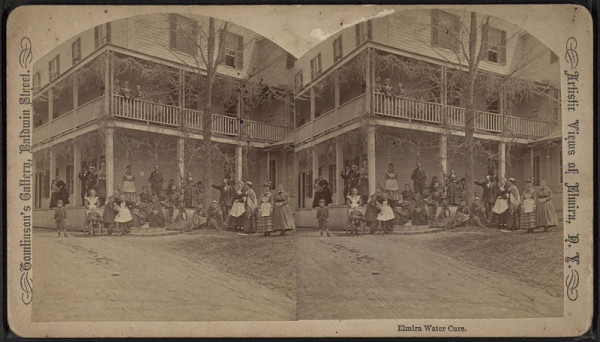
Notes:
Nearly all of my information for this post was gathered from a few short visits to the Chemung Valley History Museum (operated by the Chemung County Historical Society) and the Steele Memorial Library in Elmira. My short trips home don’t allow me much time for research (I didn’t even have time to get into their research room), but I’m beyond grateful to a certain archivist who pointed me towards three key sources:
- The Chemung Historical Journal, Vol 12, No 2, December 1966
- The Chemung Historical Journal, Vol 32, No. 2, December 1986
- The Chemung Historical Journal, Vol 54, No. 2, December 2008

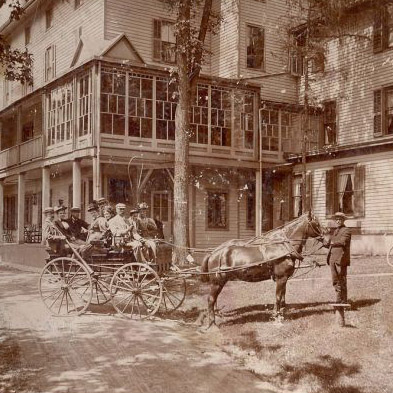
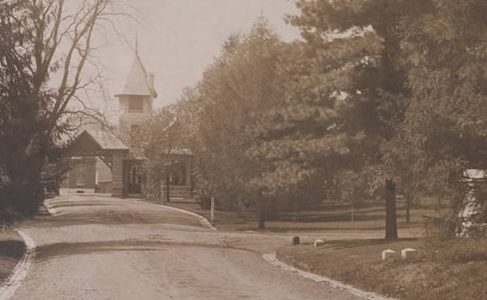
You mention that Clemens was skeptical of the water cure. Based on some of the names of those who attended, it doesn’t seem that it was a decided subject in their day. Is it safe to say that his daughter Jean never attended in hopes of remedying her epilepsy? Also, didn’t the family avail themselves of some “spa treatments” while traveling abroad in Europe? I would venture to guess that some of those spas would have been similar in nature to the Gleason’s facility?
I absolutely appreciate all of your excellent research and writing. Happen to be reading “Mark Twain and the Colonel: Samuel L. Clemens, Theodore Roosevelt, and the Arrival of a New Century” so this entry was all the more fascinating.
Thanks for investing your time and energy into such worthy history.
First of all, thanks for reading! One source did mention that Twain may have kept his skepticism of the water cure primarily to himself, knowing his in-laws were patients. As for Jean, I do not know. I didn’t come upon any information about his actual children being treated. Next time, I need to spend some time in that research room at the Historical Society.
I just posted an entry on my FB page about Watercure Hill. I was home visiting family in Elmira and had my dad in the car. As we drove past Watercure Hill, my dad (89 y/o) shared with me the history!… Not to the depth this fine article did though… Just the origins of it’s name….. I’ll be sharing this link on that thread !!!! Tks for your efforts! Bill McDonald
So much great history in Elmira. I was back in town a few weeks ago visiting my Mother. I live in St. Louis now, but Elmira will always be my home. Thanks for reading!
By the way, I also wrote a post about the Langdon Mansion in Elmira: http://www.distilledhistory.com/langdonhouse/ Cheers!
Thanks that was such a good read. Cheers, Bob Sargent
I am also from Elmira and I loved the blog and love to hear about my hometown thanks for the read christine
My pleasure! Thanks for reading.
Great post ~ I have always been fascinated about the “water cure” and remember my Dad telling me it was near Quarry Farm. I would love to read more about my old hometown of Elmira in the future!
I wrote a post a couple years ago about the Langdon Mansion that once stood at the corner of Church and Main. I bet you’d get a kick out of that one as well. Thanks for reading!
Wow great stuff, excellent post. Gone through Elmira many times (the nearby Corning Glass Museum is awesome) but had no idea what went on there. Re tonic syrups, have you tried Pinckney’s? Very strange, makes a pink G + T. Needs lime for balance, and a soda stream or selzer for the fizz, but an interesting drink. Look forward to trying the others.
http://www.onlytonics.com/pinckney-bend-tonic-syrup-16-9fl-oz/?gclid=COPYldbAgsMCFZABaQodC68Akg
I have not tried Pinckneys! I do like the syrups, but some of them tend to make the drink a bit too sweet for me. I prefer the homemade tonics where I have control of the ingredients. But thanks for the suggestion. I’ll try it out! And of course, thanks for reading.
Not having lived in Elmira, my birth city, for several decades, reading your article about the Gleason sanitarium, totally piqued my interest to research some of the place names I remember. As a child, for instance, I never thought to wonder where the name Watercure Hill came from. I’m so glad to learn and now be challenged to uncover more Elmira history.
I never thought about stuff like that either when I lived there. It’s great to go back blow the dust off things, isn’t it?
I also grew up in Elmira and have lived here for 67 years always thinking about leaving, yet I never did and took so much the history for granted. Hiking and playing on Watercure Hill was great enjoyment, but reading your post has given me a new appreciation for my “old” neighborhood and the great town I live in. Thank you so much.
I lived in st Louis for 3 years and I loved my adopted city. I will be back for the mayor’s mardi gras ball
We’re drinking and loving your blog here. Nicely done! My dad’s house is at the foot of the hill behind this place and crockery regularly comes out of the Cliffside…come back and investigate!!
“drinking and loving your blog”. Best comment ever!
Excellent article….teach that to the high school population in Elmira today.
My great grandfather told me many stories of himself and Samuel Clemens and John Palmer and myself would hike up east hill and play in his study.That study is now at the college. Great place back in the day now not so much
You SOB! I am in elmira one night and you were in town. When you get to NYC give me a call so we can share a gin martini.
Welcome back! Glad you are back writing and feeling better. I knew bits and pieces of the Gleason story, but you really fleshed them out and made the Watercure tangible. I particularly liked seeing the photos and postcards that I’ve never seen before! Great article, Cameron!
Love your blog, and I’m glad your head has recovered! 🙂
commence keeping them coming, Cameron! Sorry for the alliteration–I need a G&T!
I thoroughly love the flair and style of your writing. This information is wonderful and you occasionally inspire me to try new things – like stirring my martini instead of shaking it. Now I’m inspired to try and make my own tonic water. I usually try to buy tonic in small glass bottles that make one tall drink or two smaller cocktails. But finding glass is getting harder and I prefer schweppes to other brands because it seems to have less sugar. In the meantime, I’ve seen a gadget called a “Soda Stream” for making soda at home. I’m wondering about adapting one of those to make my own tonic. I found this source for cinchona that you might want to visit http://cinchona-bark.com. Thanks Cam!!
Hey Mr. Nagle. Exactly! I have a soda stream and use it for just that purpose. Soda Stream also makes their own tonic and diet tonic syrups, but I use it more with the syrups that are mentioned above. And of course… thanks for the nice words about the blog. I’ll be home at some point this summer, so we’ll have to talk stir vs. shake a bit more then.
it was wonderful to stumble across your blog. my father in law built his house in the little cavern beneath where the nursing home had been about 45 years ago, just to the left, then quick right as you come over the bridge from Elmira. His name was Laurence Gray. His widow still lives there. so many happy memories there. it was fun to read of the surrounding area! thank you for your great research, time and heart.
“Research, time, and heart.” That’s one of the most meaningful comments I’ve received in the history of writing this blog. I really do pour my heart in to this thing, so thank you for recognizing it. I’ll be back in Elmira in a couple months, and I’m sure I’ll find another great topic to write about!
I was looking up information on the Gleason Sanitorium because my 3 times Great Grandmother worked as a matron there around the late 1880’s, and as a maid and waitress in earlier years. This post was great to read.
Your article is very informative. Thank you for posting this information. I am researching a couple, Frederick Betts Eliot and his wife Susan (Scott) Eliot, both of whom died at the Gleason Health Resort (Frederick on May 16, 1912) and Susan on Nov 2, 1912) I’ve posted newspaper clippings on findagrave.com http://www.findagrave.com/cgi-bin/fg.cgi?page=gr&GRid=97534065 and http://www.findagrave.com/cgi-bin/fg.cgi?page=gr&GRid=97433300
Is there a way to find out what they died from? Any records exist from that time period that would show what they went there for (illness) and what treatments they received?
Thank you.
Just came across your excellent post while researching Harriet Beecher Stowe. Recently while researching Magnolia Springs in North Florida, I came across an account of Seth Rogers, who had a hydropathic institute in Worchester, Mass. Turns out Rogers was Susan B. Anthony’s cousin. I will email you a photo I took of the account. I very much enjoyed your post!
Hello, can you (or anyone) tell me where I might get high resolution photos of the Elmira Water Cure buildings and permission for use in a book? Thank you.
I would try the Chemung County Historical Society. The Steele Memorial Library may also be able to help.
Gee it is too bad they knocked down the building. I loved your article! Such History … I am from Corning, NY but the interest was over whelming.. Thank You! So very Much..
Knew a lot about Watercure Hill Rd because my family bought the Beecher house in 1965 and I loved the history behind it. My siblings and I were afraid to go in the stone cellar because we thought there may be remains of slaves from the underground railroad.It was a great house for seven kids and my grandparents made over the carriage barn and moved into it. They introduced me to manhattans which I love to this day. Great article !
Thank you! I enjoy writing about Elmira. I’ll be back there in a month or so, so maybe I’ll start looking into another fun topic like this.
Really enjoyed reading your article. I was born & raised in Elmira & articles like yours really interest me. I’m also a g&t fan and once I discovered Fever Tree I was hooked. England has a lot of different tonics I wasn’t aware of and can’t find in the US. Hope to see more of your articles!
Enjoyed this read . My sister and her family lived on watercure hill road for most of 50 years . Now i know where the name started . Jeff Dalsis